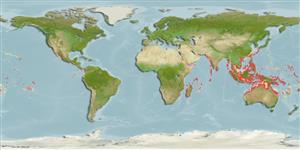Environment: milieu / climate zone / depth range / distribution range
Ecologia
marino associati a barriera corallina; distribuzione batimetrica 2 - 40 m (Ref. 1602). Tropical; 32°N - 32°S
Indo-Pacific: Sri Lanka east to Samoa and Tonga (Ref. 2334), north to Japan (Ref. 559), south to Onslow, Australia.
Size / Peso / Age
Maturity: Lm ? range ? - ? cm
Max length : 25.0 cm TL maschio/sesso non determinato; (Ref. 2334); common length : 12.5 cm TL maschio/sesso non determinato; (Ref. 9893)
Spine dorsali (totale): 0; Raggi dorsali molli (totale): 62-73; Spine anali 0; Raggi anali molli: 48 - 55. Eyes on right side. Dorsal and anal fins separate from caudal fin; pectoral fins absent; pelvic fins unequal, the right one with an elongated base and attached posteriorly to genital papilla (Ref. 9893). Series of toxic glands along the bases of dorsal- and anal-fin rays, their pores visible (Ref. 9893). Reddish brown, densely spotted on head; body and fins of ocular surface also with spots of various sizes and shapes, bordered by a dark rim and some with a blackish spot on center (Ref. 9893).
Occurs on sand and mud bottoms of lagoon and seaward reefs (Ref. 1602, 48637). Burries itself in the sand (Ref. 48637). Feeds mainly on benthic invertebrates, especially small crustaceans (Ref. 9893). Extract from sac under the skin is toxic (Ref. 559) and the mucus appears to have shark-repellent qualities.
Life cycle and mating behavior
Maturità | Riproduzione | Deposizione | Uova | Fecundity | Larve
Allen, G.R. and R. Swainston, 1988. The marine fishes of north-western Australia: a field guide for anglers and divers. Western Australian Museum, Perth. 201 p. (Ref. 3132)
IUCN Red List Status (Ref. 130435)
Human uses
Pesca: commerciale
Informazioni ulteriori
Nomi ComuniSinonimiMetabolismoPredatoriEcotossicologiaRiproduzioneMaturitàDeposizioneSpawning aggregationFecundityUovaEgg development
BibliografiaAcquacolturaProfilo di acquacolturaVarietàGeneticaElectrophoresesEreditarietàMalattieElaborazioneNutrientsMass conversion
Strumenti
Special reports
Download XML
Fonti Internet
Estimates based on models
Preferred temperature (Ref.
123201): 24.8 - 29, mean 28.1 °C (based on 986 cells).
Phylogenetic diversity index (Ref.
82804): PD
50 = 0.5156 [Uniqueness, from 0.5 = low to 2.0 = high].
Bayesian length-weight: a=0.01000 (0.00584 - 0.01711), b=3.10 (2.95 - 3.25), in cm total length, based on LWR estimates for this species & (Sub)family-body (Ref.
93245).
Trophic level (Ref.
69278): 3.1 ±0.26 se; based on food items.
Resilienza (Ref.
120179): Medio, tempo minimo di raddoppiamento della popolazione 1.4 - 4.4 anni (Preliminary K or Fecundity.).
Fishing Vulnerability (Ref.
59153): Low vulnerability (15 of 100).
Nutrients (Ref.
124155): Calcium = 68.5 [25.4, 247.9] mg/100g; Iron = 0.583 [0.244, 1.161] mg/100g; Protein = 18.3 [16.3, 20.4] %; Omega3 = 0.0664 [, ] g/100g; Selenium = 29.2 [14.6, 61.1] μg/100g; VitaminA = 65.7 [17.3, 257.1] μg/100g; Zinc = 1.22 [0.74, 1.78] mg/100g (wet weight);
